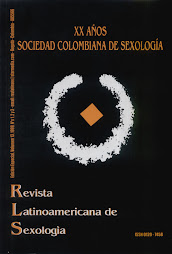Ruben Ardila
www2.hu-berlin.de/sexology/IES/colombia.html
The International Encyclopedia of SexualityVolume I - IV 1997-2001
Edited by Robert T. Francoeur
Reproduced here by permission of the editor and The Continuum Publishing Company,370 Lexington Avenue, New York, NY 10017
Copyright © 1997-2001 by Robert T. Francoeur
There has long been an interest in homosexuality in Colombia. Behaviors that can be categorized as homosexual have been noted within the cultures that existed in Colombia during the arrival of the Europeans. However, the study of homosexuality is filled with methodological ambiguities. There are certain behaviors that may or may not be considered homosexual by today’s societal standards. Even so, these behaviors existed long before the arrival of the Spaniards. As in other cultures, homosexual behaviors were found more frequently among men than women.
From the onset of studies on sexuality amongst Colombians, homosexuality was always an interest (Alzate 1978, 1982; Botero 1980; González 1985). It was found that there were differences in homosexual activity between men and women. In Bogotá, 28 percent of the men and 13 percent of the women reported having had same-sex relationships. Interestingly, there was a marked difference between the various cities in Colombia. These ratios are not limited to homosexual activities exclusively. It reflects the number of individuals who engaged in some type of sexual activity with someone of the same sex. It could have been an isolated incident and/or the regular practice of homosexual or bisexual behaviors.
Anthropological and Social Aspects
José Fernando Serrano (1997, 1998), an anthropologist, has pointed out that the formation of the homosexual identity, as described by societal constructs, has been a long process. He reviewed sociological studies originating in Colombia and indicated which ones supported the argument of sexual orientation. He also argued the problem of collective identities at the international level.
The modernization of Colombia, which took place in the latter half of the twentieth century, enabled people to look outside their immediate society and expand their provincial traditions. It enabled them to study ideas from other countries, primarily from France and other regions of Europe, and the United States. The gay and lesbian liberation movements of Germany, several other European nations, and later from the United States slowly made their way to Colombia. Nevertheless, they had a great impact on the organization of the gay and lesbian movements. Modernization gradually brought about internationalization, globalization, and societal changes that influenced people’s private lives.
Homosexual Identity
The beginnings of organized homosexual groups in Colombia began in 1970. Manuel Antonio Velandia, a sociologist and philosopher, initiated them. He associated with people who were interested in human rights, social change, and the general counterculture of the 1960s and 1970s on an international level. These gay and lesbian movements were difficult to organize, and were at times very short lived. Finally, in the late 1980s and 1990s, gay and lesbian groups succeeded in uniting and achieving their goals (Velandia 1999).
Velandia founded the Gay Liberation Group and the Homosexual Liberation Movement of Colombia in 1976. He also organized the first Gay Pride March in 1982 in Bogotá. These movements gained importance in 1998 and 1999 and included weeklong lectures on sexual diversity, collective identity, human rights, legislation, and other related topics. However, gay and lesbian communities are slow in coming. Although gay meeting places have been established since the 1970s, homosexual literature remains unseen. The first writings pertaining to the gay lifestyle - poetry, novels, theater, and soap operas - surfaced in the 1980s. This is not to discount earlier works by P. Barba Jacob. Today, soap operas and movies frequently touch on homosexuality.
The Constitution of Colombia, passed in 1991, prohibits discrimination in any form or manner. It recognizes that all people have the right to free personal development. The Constitution stipulates that homosexuals may not be discriminated against based on their sexual orientation. Sexual orientation that is not shared by the majority does not justify unequal treatment.
The rights given by the Colombian Constitution pertaining to sexual orientation during the 1990s have been favorable for homosexuals and bisexuals. For example, in April 1991, a law was passed that protects an individual’s rights to free sexual identity. It affirms that homosexuality should be considered valid and legitimate. The Colombian Constitution also addressed the debate regarding homosexual educators. They determined that homosexuality has no bearing on an individual’s ability to teach (in September 1998). Additionally, in July 1999, the Colombian legislature passed a law protecting homosexuals in the military. It states that individuals may reveal their status as homosexuals and continue to be held to the same norms and expectations as heterosexuals.
The Colombian legislature has defined the family as a union of a man and a woman (March 7, 1996). However, it went on to acknowledge the rights of partners, including same-sex couples, in terms of inheritance, transfer of assets, and financial support, among other things. There have been several attempts to legalize homosexual marriages, as has been done in several other areas, e.g., Denmark since 1989, Norway since 1993, Sweden since 1995, Iceland since 1996, Hungary since 1996, and Holland since 1997. In some cases, there exist legal sanctions against same-sex marriages because of the possibility of adoption. There are, however, gay activist groups who support the legalization of the gay family in all aspects, including adoption. The Family Pride coalition is one of the most important advocates of this movement.
One of the most recent proposals, in September 1999, sought to equalize the rights of homosexual couples with those of heterosexual couples. For instance, after two years of cohabitation, the couple may apply for Social Security benefits. Additionally, should the relationship end because of death, one partner may inherit the assets of the other. There already are companies in the private and public sectors that will allow an employee’s partner of the same sex to register for benefits.
Psychological Investigations
Psychological studies regarding homosexuality, bisexuality, and homoeroticism have been conducted by Octavio Giraldo and his team (1979, 1981, 1982) at the University of “El Valle.” Similar studies have been lead by Ruben Ardila (1985, 1986, 1995, 1998) at the National University of Colombia.
Ruben Ardila has focused on sexual orientation in the studies he has conducted for the past 15 years. Some of the issues he has researched have been: adaptation of homosexual males, lesbianism, sexual orientation, heterosexual attitudes towards homosexuals, stability of the homosexual couple, the life cycle of homosexuals and lesbians, the biological aspects of homosexuality, politics as they pertain to homosexuality, and other related topics.
One such study looked at the adaptation of male homosexuals (Ardial, 1998). There were 100 subjects, between the ages of 18 and 52 years of age. They all scored a five or six on the Kinsey Scale (indicating predominantly or exclusively homosexual). The following factors were studied: depression, solitude, timidity, social alienation, interrelations with heterosexuals, interrelations with homosexuals, sexual practices, traditional values, religion, morals, conformity, acceptance of homosexuality, emotional stability, guilt, concept of homosexuality as a mental illness, effeminacy, responsibility, interrelations with the opposite sex, secretiveness of homosexuality, personal adjustment, and psychosomatic symptoms.
The results indicate that Colombian homosexuals are well adapted and do not present any pathological qualities. However, 10 percent manifested signs of severe depression, while 44 percent were highly stable. Only 4 percent reported feeling guilty about their homosexuality. Fifty-nine percent stated that they had positive interpersonal relations, and 48 percent accepted their homosexuality. For further material on diverse aspects of sexual orientation for both women and men, see the References and Suggested Readings section.
Sexual Orientation in Colombian Society
Our society, based on the Judeo-Christian faith, has a very negative attitude towards homosexuality. Homosexuality is viewed as a violation, an illness, or a deviation from the norm that threatens normal behaviors and society. This homophobic view has permeated Colombian society throughout its history, although, there have been different levels of acceptance, depending on the individual’s level of education, rural-versus-urban setting, age, and their affiliation with the Catholic Church. There is a deeply rooted belief that homosexuals are a threat to society, good upbringing, and family values. Similarly, homosexuality is thought to be related to child sexual abuse, AIDS, substance abuse, delinquency, and other serious social problems.
Homosexuals are discriminated against in education, in the workplace, in housing, in the mass media, and generally in daily living. This homophobia has its origins in the Latin-American cultures, which practice machismo, emphasize the importance of the family unit, and are highly influenced by the Catholic Church. In spite of this, the situation has considerably improved in recent years, from the homosexual liberation movements in the 1970s to the legislative, medical, and psychological advances that occurred later. In the larger cities of Colombia, especially those with higher levels of education, homosexuals are accepted. They are respected and are considered equal to heterosexuals. In these areas, discrimination is hardly noticeable. It is no longer believed that male homosexuals are less masculine than heterosexual males or that lesbians are any less feminine than female heterosexuals are. Additionally, there are certain groups within the Church who have worked towards improving the quality of life for gays and lesbians. Social support has shown improvement, which will then lead to a more pluralistic, diversified, and egalitarian society.
Suscribirse a:
Enviar comentarios (Atom)











.jpg)






















No hay comentarios:
Publicar un comentario